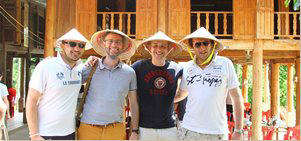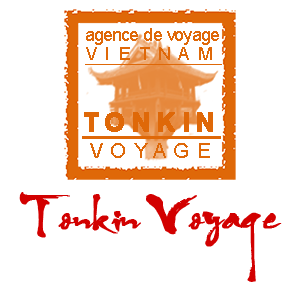Hanoi is the capital of Vietnam and is the center of politics, culture and tourism within the country. In October 2010 it had its 1000 year anniversary.
Hanoi
Hanoi is situated on the banks of the Red River, 1760km from Ho Chi Minh City and has a long and fascinating history, numerous cultural and architectural works and famous historical sites. The city attracts the largest number of foreign tourists with its scenic beauty and fascinating history. By and large, Hanoi has an understated elegance shaped by thousands of years of civilization.
Airport
Noi Bai International Airport is about 35km from the city center. This is one of the largest airports in the country providing domestic and international flights. It takes about 40 minutes by taxi or bus to the center of Hanoi from the airport.
Ideal climate for the journey
Hanoi is in a tropical climate zone subject to the monsoon seasons. The hot season extends from May to September (up to 40oC) and is also rainy. From November to March, it is winter and the weather is dry and sometimes very cold (minimum 5oC). The most appropriate time to visit Hanoi is autumn, from early September to November. At this time, the weather is cool and increasingly dry. Autumn in Hanoi is present in many works of literature and music known by all Vietnamese.
Typical religious monuments
As the center of Buddhism and Taoism in Vietnam for centuries, Hanoi has many old temples with ancient features. Among these monuments is Tran Quoc Pagoda, built during the reign of King Ly Nam De (6th century). Another symbol of Hanoi is the One Pillar Pagoda, which is the only Vietnamese architectural element in the shape of a lotus. Located in the heart of the city and in the middle of Hoan Kiem Lake is Ngoc Son Temple, built in the 19th century.
Since the 19th century, many churches were built in Hanoi and the best known is the impressive St. Joseph’s Cathedral. Located in the Old Quarter, this Gothic Revival style church design is loosely based on that of Paris’ Notre Dame Cathedral. Cua Bac Church, located in the French Quarter, is also remarkable with French colonial style architecture and vibrant ochre colour.
Attractive discovery of culture
The first and oldest university in the country is fittingly called the Temple of Literature. This is also the place of worship of Confucius and is where the names of Vietnam’s first doctors were engraved on the back of turtles.
Travellers can also visit a monument built by the French: our world class Opera House. This is one of the cultural centers of Hanoi, where frequent musical and dance performances, as well as art shows, lectures and meetings are held.
The most diverse museums Vietnam has to offer are located in Hanoi. The must-see list includes the Museum of Vietnamese History, the Museum of Ethnology, the Museum of Military History, the Museum of Victory B52, the Revolution Museum, Vietnamese Women’s Museum and the Museum of Fine Arts.
A stroll through the Old Quarter
The Old Quarter of Hanoi is a unique feature of the city with houses and streets that retain their 19th-century appearance. Visitors, and locals, can wander all day through the narrow streets, discovering small and lively corners.
Politics
Travellers can stroll around Ba Dinh Square, the political center of Vietnam, and walk past the Presidential Palace or visit the Mausoleum of President Ho Chi Minh, who read the Declaration of Independence on this very spot on September 2, 1945.
Culture
Walks around the lakes are very popular with both visitors and locals alike. Hanoi is special because there are many lakes in town and it is also surrounded by rivers. The most famous is Hoan Kiem Lake which is located in the city center and is the backdrop for many different activities such as cultural performances, fireworks, celebrations, etc. Every weekend, from Friday evening to Sunday evening, the streets around the lake are closed to motor traffic and pedestrians of all ages flock to the lake to take a stroll, jump rope, visit with friends, or learn to rollerblade. The largest is Tay Ho, or West Lake, which offers a calm break from the bustle of Hanoi. In the evening you can take a dinner cruise around the lake and during the day you can rent a pedal boat or enjoy a Vietnamese coffee at one of the many lake front cafes.
Important traditional festivals
Besides visiting attractions, travellers should not miss Hanoi’s many traditional celebrations. These festivals are held mainly in spring and commemorate historical figures and legendary heroes.
Vietnam’s most important festival is the lunar New Year celebration called Tet. The dates shift every year based on the lunar calendar but the week-long celebration generally falls in January or February. Leading up to Tet, all of Vietnam is abuzz with families buying their cumquat or peach blossom trees and preparing to feed the large number of friends and family who will visit during the celebration. During the week of Tet, most Vietnamese will travel home to reunite with family and visit pagodas to worship. If you happen to be in Vietnam during this festive season, it’s a wonderful site to see but you may experience travel delays and many businesses close.
Other interesting cultural festivals include Thi Cam Village’s rice cooking contest, the kite flying festivities in Ba Giang Village, and the Giong festival, which honors the mythical hero Thanh Giong, at Soc Temple.
Place of interest
-
Northern Vietnam
- Where & When to visit the rice terraces in North Vietnam
- Huong Pagoda – Pilgrimage to the land of Buddhas
- Day Trips from Hanoi
- Things to do in Hanoi
- Hanoi, City of Peace
- Ninh Binh Province
- Bat Trang, ceramic art destination
- Duong Lam ancient village
- Tay Phuong Pagoda, the destination to calm down
- Cat Ba Island, World Biosphere Reserve
- Central Vietnam
- Southern Vietnam






